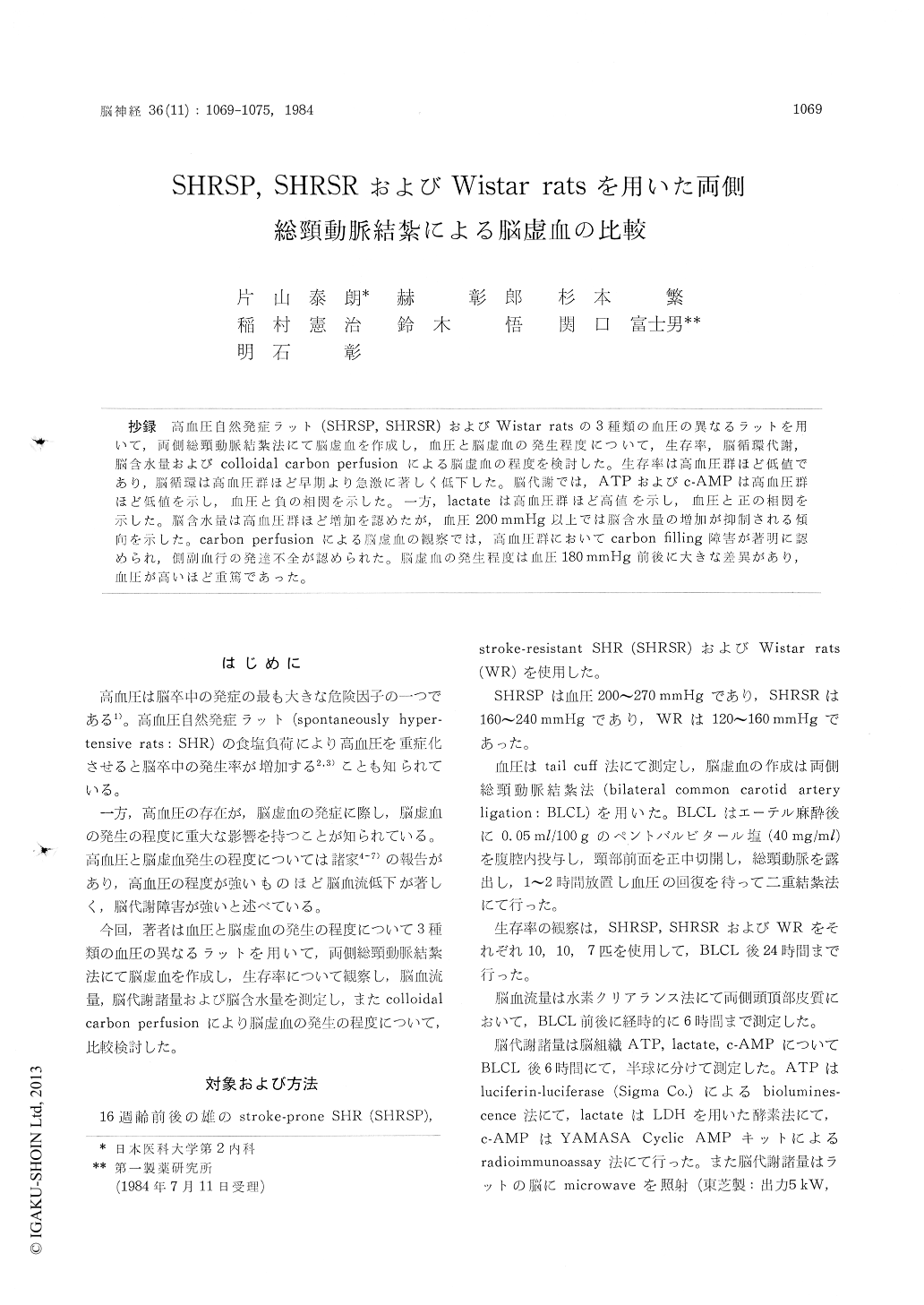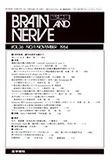Japanese
English
- 有料閲覧
- Abstract 文献概要
- 1ページ目 Look Inside
抄録 高血圧自然発症ラット(SHRSP,SHRSR)およびWistar ratsの3種類の血圧の異なるラットを用いて,両側総頸動脈結紮法にて脳虚血を作成し,血圧と脳虚血の発生程度について,生存率,脳循環代謝,脳含水量およびcolloidal carbon perfusionによる脳虚血の程度を検討した。生存率は高血圧群ほど低値であり,脳循環は高血圧群ほど早期より急激に著しく低下した。脳代謝では,ATPおよびc-AMPは高血圧群ほど低値を示し,血圧と負の相関を示した。一方,lactateは高血圧群ほど高値を示し,血圧と正の相関を示した。脳含水量は高血圧群ほど増加を認めたが,血圧200mmHg以上では脳含水量の増加が抑制される傾向を示した。carbon perfusionによる脳虚血の観察では,高血圧群においてcarbon filling障害が著明に認められ,側副血行の発達不全が認められた。脳虚血の発生程度は血圧180mmHg前後に大きな差異があり,血圧が高いほど重篤であった。
Three different pressure groups of rats, stroke-prone spontaneously hypertensive rats (SHRSP, 200-270 mmHg), stroke-resistant SHR (SHRSR, 160-240 mmHg), and Wistar rats (WR, 120-160 mmHg) were used to investigate the effect of priorly existing hypertension on the severity of brain damage induced by ischemia. The cerebral ischemia was induced by bilateral common carotid artery ligation (BLCL) and the survival rate, cere-bral blood flow, cerebral energy metabolites (ATP, lactate c-AMP) and water content were measured. Colloidal carbon perfusion was also performed.
Sixteen-week-old male rats were used. The sur-vival rate was observed until 24 hours after BLCL. Cerebral blood flow was measured in parietal cortex by hydrogen clearance method. ATP was measured by luciferin-luciferase method, and lactate by enzymatic method using LDH. c-AMP was measured by radioimmunoassay. Brain water content was measured by freeze-dry method. These measurements were done for animals surviving 6 hours of BLCL. Colloidal carbon perfusion was done according to Ames' Method.
The survival rate was lower in the hypertension group. The survival of SHRSP and SHRSR were 20% compared to 71% in WR after 24 hours of BLCL.
The cerebral circulation of SHRSP fell abruptly and was near to zero after one hour of BLCL. In SHRSR this fall of cerebral blood flow was pro-minent in the rats of higher blood pressure. On the other hand there was no apparent fall of cerebral blood flow in WR after BLCL.
The cerebral energy metabolites, ATP and c-AMP showed the lowest level in SHRSP which had the negative correlation to blood pressure. On the other hand, lactate was highest in SHRSP which showed positive correlation to blood pres-sure. Remarkable decrease of ATP and c-AMP and large increase of lactate were recognized in the animal that had blood pressure more than 180 mmHg.
The brain water content was highest in the SHRSR which showed a positive correlation to blood pressure. But the rate of edema production was suppressed in hypertension more than 200 mmHg.
Colloidal carbon filling of rat brains was sparse in SHRSR and SHRSP 1 and 3 hr. after BLCL. Carbon filling defect of frontal section of the same specimen was most prominent in the cortex and deep region of SHRSP 3 hr after BLCL. While it was not observed in WR. The fall of cerebral blood flow and aggravation of cerebral edemawere more prominent in hypertensive group. Therefore, the higher the blood pressure, the survival rate was worse. Accordingly, it is shown that when cerebral ischemia occurs, the degree of preexisting hypertention is one of the largest factors which determine the degree of cerebral ischemia.
It is indicated that the animals which have the blood pressure more than 180 mmHg may be more vulnerable and susceptible for ischemia in ischemic insult.

Copyright © 1984, Igaku-Shoin Ltd. All rights reserved.


